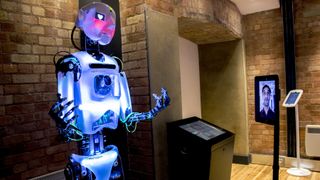
The phrase 'working from home', so often accompanied by air quotation marks when referred to by those who are chained to their offices, is starting to take on new meaning. This shift in emphasis is a result of new and evolving technologies that are bringing the office, virtually, into our homes, and us, virtually, into the office.
But the idea behind this rapidly evolving working revolution isn't a new one and is based around the word 'telepresence' – which itself has influences as far back as 1918.
Telepresence (noun): The use of virtual reality technology, especially for remote control of machinery or for apparent participation in distant events.
Telepresence was first mentioned in a 1980 article by US cognitive scientist Marvin Minsky, and has always been as much about science fiction as science fact. Indeed, Minsky himself attributed the development of the idea behind the word to renowned American sci-fi author Robert A Heinlein and his 1942 short story 'Waldo', which shows technology being manipulated as an extension of ones self.
Harnessing technology
Published initially in Astounding Science Fiction magazine in August 1942 under Heinlein's pseudonym Anson MacDonald, Waldo tells the story of Waldo Farthingwaite-Jones, a physically challenged but rich man who channels his intellect and family fortune into patenting a device to help offset his physical disability. The Waldo F Jones' Synchronous Reduplicating Pantograph (Waldo for short) is a powerful mechanical hand enabled by the use of gloves and a harness.
Waldo was later the nickname attributed to all remote manipulators, possibly as early as 1945 when Central Research Labs was given the contract to develop a radioactive manipulator for the Argonne National Laboratory near Chicago.
Heinlein himself referred to an even earlier influence for Waldo – a 1918 article in Popular Mechanics about a man with an autoimmune neuromuscular condition who "devised complicated lever arrangements to enable him to use what little strength he had". Where this unfortunate but clearly innovative chap drew his influence from is anyone's guess, but the idea of using technology to enhance or redefine the human condition is clearly not new.
Are you a pro? Subscribe to our newsletter
Sign up to the TechRadar Pro newsletter to get all the top news, opinion, features and guidance your business needs to succeed!

Spirit of Waldo
Of course, it's only in recent years that telepresence has become increasingly associated with videoconferencing and working away from the office, with companies such as Double Robotics creating relatively simple technologies that allow us to remotely cruise the corridors of our workplace looking for the meeting room while lying in bed recovering from whatever ailment is keeping us from the office.
According to Double Robotics, its Double telepresence robot provides "a physical presence at work or school when you can't be there in person". Double featured during the premiere of the fifth season of CBS' The Good Wife, with the show's writers using it as light relief (the out-takes are hilarious). In reality, Double is a very clever, yet simple telepresence solution that works very well indeed and is true to the spirit of Waldo.
Comprising what looks like a dismantled motorised golf cart, with self-balancing tech, motorised-adjustable-height controls and a wide angled lens, the $2,500 (around £1600, or AU$3400) Double requires the additional purchase of two iPads. Driver apps – allowing you to drive your virtual self anywhere in the world – are included, with the travel case and charging dock costing extra.
The iPad sits atop the 'cart', acting as a virtual you. Meanwhile, you control the Double's movement from another iPad, which also transfers visuals and audio – the virtual you – to the Double. It's a bit creepy to begin with, but once you've sat for a few minutes in a meeting with virtual iPad colleagues, it soon becomes the norm.
iPad avatars
Heinlein might well have expected something slightly more robotic than an iPad with a big wheel by now, but this move towards mobile telepresence videoconferencing is certainly a departure from the standard, yet hugely successful – and rapidly evolving – screen-in-the-boardroom solution. And with robotics technology continuing to progress at pace, it surely won't be long before our robotic avatars are attending meetings clutching iPads rather than wearing them as our faces.
Given that fact tends to follow fiction, perhaps 2005's Japanese movie Hinokio (get it?!) could provide prescience as to what we might expect. The story of a wheelchair-bound boy who communicates with the outside world and attends school as a robot, it premiered last year in the US at the fourth Annual Robot Film Festival in San Francisco. With Hinokio being bullied at school (how long before we see a court case regarding in-office telepresence bullying?), it certainly illustrates some of the potential benefits and challenges of telepresence robotics.
Most Popular
